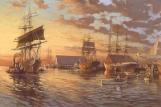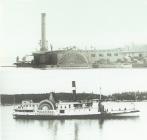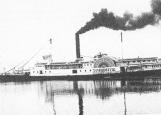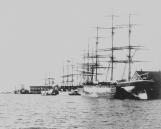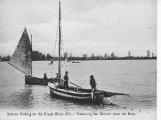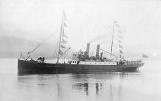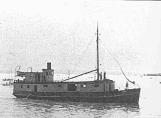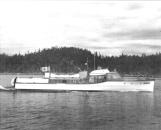

Steveston Museum
Richmond, British Columbia
1
The Fraser River was the highway of the pioneers of British Columbia. It was the means of access to land, to gold, and to markets. It also provided abundant wealth in the form of salmon. All manner of boats have been used over the years to catch those fish, and to transport people and supplies. These are just a few that plied the water around Steveston.3
"Days Of Glory"This John M. Horton painting, "Days of Glory", produced especially for the Tall Ships Festival in August 2002, illustrates the wonderful era of sailing that brought Steveston to the world's stage more than a century ago. Although these magnificent ships only arrive in the harbour now on special occasions, the waterfront is alive with other commercial and fishing vessels.
5
ENTERPRISE AND WILSON G. HUNTThe first wooden side-wheeler to travel between Victoria and New Westminster on the Fraser River was the ENTERPRISE, built in San Francisco in 1861 and operated by the Hudson's Bay Co. from 1862 to 1885. At 143 feet, she carried passengers, mail and freight twice a week in summer and once a week in winter, ice permitting. The similar sized WILSON G. HUNT was built in San Francisco in 1858 and bought by Captain John Irving of the Pioneer Line to compete with the ENTERPRISE. Both boats stopped at Ladner's Landing, London's Landing and Steves' Landing. The WILSON G. HUNT completed its last run in 1881 when it was sold. The ENTERPRISE was wrecked in a collision in 1885.
7
SIDE WHEELER YOSEMITEIn 1878 the Hudson's Bay Co. paid $75,000 for the 180-foot wooden side-wheel steamship OLYMPIA built in 1869 for $200,000. She was renamed the PRINCESS LOUISE and took over the Victoria-New Westminster route stopping at Steveston on the way. The Hudson's Bay Co. fleet merged with the Pioneer Line in 1883 to form the Canadian Pacific Navigation Co. Its manager, Captain John Irving, then bought the 282-foot side-wheel steamship YOSEMITE, built in California in 1862, for $20,000. Her paddlewheels were 32 feet in diameter and 10 feet wide. She could make the trip from Victoria to New Westminster in 4 hours and 20 minutes. The CPR bought the CPNC in 1901 and sold both these aging vessels.
9
CLIPPER SHIP TITANIAOn July 25, 1889, the Hudson's Bay clipper ship TITANIA arrived in Vancouver - the first ship to bring cargo directly from Great Britain. It was chartered by H. Bell-Irving whose ABC Company purchased 9 salmon canneries in B.C. in 1891. On her return trip, the TITANIA carried the first cargo of canned sockeye salmon from B.C. to England. She docked in Steveston at the Britannia wharf while the cannery was still under construction, loaded the fish, and left on September 28, 1889. She made a stop in Victoria and arrived in London after a 104-day trip around Cape Horn. The canned salmon was so popular in Europe that Steveston became known as the "Salmon Capitol of the World".
11
COLUMBIA RIVER BOATSFraser River skiffs were replaced by 25-foot, fixed mast, round-bottomed Columbia River boats in the early 1890's. Some people claim the Columbia River boats were first built in San Francisco for the Sacramento and Columbia River fisheries but similar boats were also being built on Lake Ontario by Captain William Watts who moved west in 1888 to start the Vancouver Shipyard. The two-man crew stayed on board from Sunday night to Saturday morning, sleeping under a canvas pup tent. Steam-powered tugs collected the fish daily. Larger Columbia River boats became known as Bristol Bay boats because they fished in Alaska. The last of these was built in Steveston at David's Boat Works in the early 1950's.
13
S.S. CUTCHThe CUTCH was the Union Steamships' first successful passenger ship. This 180-foot schooner-rigged steamer was purchased in 1890 from the estate of the Maharajah of Cutch, India. This picture shows her being hired as a weekend excursion ship. She carried buyers to the Steveston sale of lots on June 16, 1891 from City Wharf at Vancouver. She was a fast, clean ship with a reputation for always being on time. From 1892 to 1896 she carried mail, passengers and freight between Nanaimo and Vancouver, stopping at Steveston on the way. The round trip cost $3.50. After 1896 she carried passengers and freight to the Klondike gold rush, was wrecked, salvaged and by 1901 was a gunboat in South America.
15
The Ferry CITY OF NANAIMOThe CITY OF NANAIMO was built in 1892 at False Creek, Vancouver, for the Mainland and Nanaimo Steam Navigation Company set up by the Dunsmuir coal mining company of Nanaimo on Vancouver Island. Their first coal-fired side-wheel steamship, ROBERT DUNSMUIR, was nicknamed "Dirty Bob" because of the coal dust and livestock on the deck. The CITY OF NANAIMO was a more spacious vessel that competed directly with the S.S.Cutch, owned by the Union Steamship Company, for the runs from New Westminster to Vancouver, and New Westminster to Nanaimo, with syops at Steveston on the way. The rivalry and racing between these two ships ended in a collision in 1896.
17
STERNWHEELER TRANSFERThe 122-foot long, 24.5-foot wide, wooden sternwheel steamship TRANSFER was built in 1893 by Alexander Watson of New Westminster. Owned by the Canadian Pacific Navigation Company, she was used exclusively on the lower Fraser River, never going into Georgia Strait. With a draft of only 5.6 feet, she was able to dock at the wharves built over the shallow marshes on the edge of the river. Considered a "modest" vessel, without the plush elegance of other passenger steamers, she was used on the run from Chilliwack to New Westminster until 1898, and then on the daily run from New Westminster to Steveston and Ladner from 1898 to 1908. She was sold in 1909 and ended her career as a power plant for a cannery at Redonda Bay.
19
TYPICAL STEAM POWERED FREIGHTERIn 1877 Marshall English built one of B.C.'s first salmon canneries on the Fraser River near New Westminster. In 1878 he established a fish camp near the Kwlhayam village to buy salmon from Native fishermen. The camp was a scow moored to the bank, with a scow house for the camp boss. Natives fishing from dugout canoes delivered fish at certain times of day, depending on the tides, to the fish camp. Marshall English then had the salmon transported to his cannery by two steam-powered boats. The river freighter LEONORA carried fish in its hold, and the tug LEVIATHAN towed a scow. The Delta Cannery had a similar fish camp at London's Landing near Steveston from 1881 to 1885.
21
S.S. COMOXThe Union Steamship Company leased land in Vancouver and built the first steel ships north of San Francisco. The 101-foot COMOX was completed in October 1891, the 120-foot CAPILANO in December 1891, and the 127-foot COQUITLAM in April 1892. On weekdays the COMOX traveled from Vancouver up the coast to logging camps but on weekends she ran excursion trips. In July 1897 she carried passengers on an excursion to Steveston to view the fishing fleet and canneries in operation. During the 1900 fishermen's strike she carried soldiers from the Duke of Connaught's Own Rifles from Vancouver to Steveston.
23
FERRY MOTOR PRINCESSNicknamed "galloping dishpan", "jiggle box", and "stinker", the MOTOR PRINCESS ran from 1929 to 1950 between Steveston and Vancouver Island with stops at Gulf Island ports on Sundays. She was built in Esquimalt in 97 days and launched in 1923 as the first diesel ferry in the CPR fleet. At 165 feet long, 43.5 feet wide and 9 feet deep, she was designed to carry 45 cars. Stubby and squat, not sleek and yacht-like as strictly passenger ferries were, she was considered an uncomfortable misfit in the Princess Line. Despite being noisy, jerky, overpowered, and hard to steer in high seas, she was a convenient and popular method of travel. She was sold in 1956, renovated, and renamed PENDER QUEEN. She became part of the B.C. Ferry fleet in 1965.
25
THOMAS F. BAYARDThe THOMAS F. BAYARD was built in 1880 as a pilot ship for the Delaware River. This 93-foot two-masted schooner was named for an unsuccessful Democratic candidate for U.S.A. president. She made a record setting 166-day voyage around Cape Horn to San Francisco to ferry people and supplies to the Klondike Gold Rush, and sailed as a sealing schooner in the Bering Straits from 1906 to 1911. Renamed SAND HEADS NO. 16, the ship served as the Steveston lightship from 1921 to 1956, warning vessels about the shoals off the mouth of the Fraser River. After several years as a private houseboat, she was bought by the Vancouver Maritime Museum in 1977 and moored at False Creek awaiting restoration. She sank in 2002 and could not be salvaged.
27
RUM RUNNERS BRING PROFITProhibition lasted from 1916 to 1921 in Canada but continued until 1933 in the U.S.A. The chance of quick and easy profit encouraged Canadians with boats to carry liquor for sale across the border to American smugglers. There were 60 boats working from the Vancouver area alone, including the M.V. FLEETWOOD. Built in 1930 and originally named SKEEZIX, this 60-foot rum runner with her diesel engine, 2 gas aircraft engines and streamlined hull was said to be the fastest boat on the coast. At speeds of up to 40 nautical miles per hour she was well able to elude the Coast Guard cruisers. In 1934 she was converted to a luxury yacht. She was donated to the Britannia Heritage Shipyard by the family of Robert Turnbull who had owned her since 1976.
